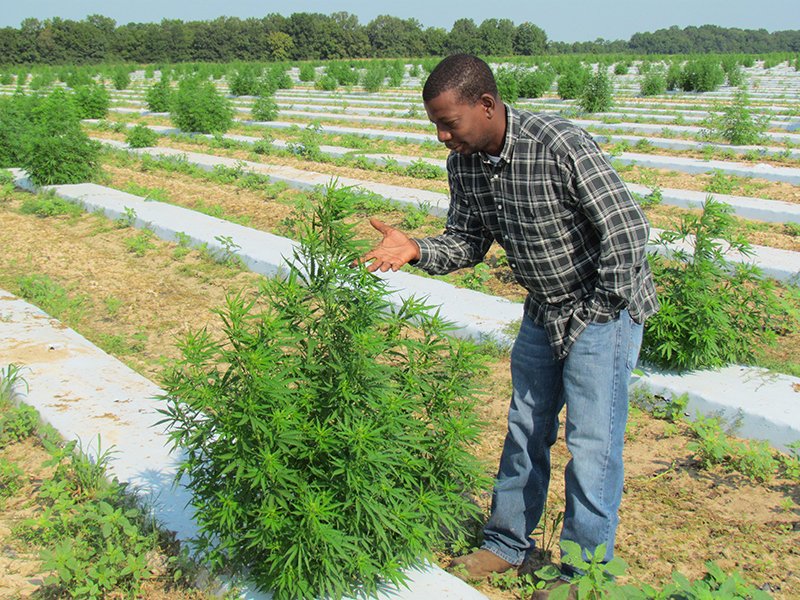PINE BLUFF -- Interest in growing industrial hemp for cannabidiol oil is increasing among small farmers because of the crop's profit potential, Henry English, head of the University of Arkansas at Pine Bluff Small Farm Program, said in a news release. The projected income of over $25,500 per acre is higher than the projected income for any row or vegetable crop.
Hemp is a variety of the cannabis stative plant, English said. Marijuana is a variety of the same plant, but the two are different, scientifically and legally. Industrial hemp contains a tetrahydrocannabinol level of less than 0.3%, which means people who consume it do not experience a "high" or any psychoactive symptoms.
"Growing industrial hemp is legal but requires annual licensing from the Arkansas State Plant Board," he said. "The crop is grown primarily for use in the production of grain, fiber and CBD oil. Ninety percent of producers grow the crop for CBD oil, which is used in a variety of products, including medical products."
To get started growing industrial hemp, a producer first needs to obtain a growers license from the Arkansas Agriculture Department. Growers can find application requirements for licenses on the AAD website at http://www.agriculture.arkansas.gov/hemp-home.
The application process requires obtaining a letter of intent from a processor or buyer that indicates it plans to purchase or buy the producer's hemp crop. Other requirements include getting a background check and identifying the intended field location with latitude and longitude coordinates.
English said the estimated income per acre for industrial hemp comes from a Kentucky enterprise budget on industrial hemp (CBD plasticulture model). The projected revenue of one acre was $36,000, based on an expected Dry Matter Yield of 1,200 pounds per acre at a price of $30 per pound (selling plants with a CBD oil content of 6 percent at $5 for each percent of CBD).
In the study, the variable or input cost -- for license fees, transplants, fertilizer, disk harrowing, plastic mulch and drip irrigation -- was estimated at $10,400, bringing the return above variable cost to $25,594.
"Industrial hemp can be lucrative, but there are several things to consider before growing it," English said. "For one, the crop requires manual labor. If you do not have manual labor available for harvest, you could end up losing your entire crop."
So far, there are only a few pesticides available for the control of weeds, insects and diseases as it relates to industrial hemp. Those that are available are mainly organic and do not adequately control pests.
"Irrigation is highly recommended since transplants cost $5,000 per acre," English said. "This will keep the plants healthy and from being stressed. If the plants get stressed, their Tetrahydrocannabinol (THC) level may go over the legal limit of 0.3 percent, which means the plants would have to be destroyed."
English said it is also important that producers consider the following soil health factors before planting hemp:
• Soil residual herbicides. These herbicides persist in the soil to control weeds over a certain length of time. Most have a plant-back interval that indicates the number of months (usually one to 18 months) needed before another specific crop such as hemp can be planted without being damaged by the current applied herbicide. If the plant-back interval has not passed, the newly-planted hemp crop could be damaged by the herbicide that was applied last year and either die or produce poor yields.
• Soil pH level. Industrial hemp grows best on loamy soils with a soil pH level of 6 to 7. If the soil pH is lower than the recommended level (a pH of 5 or below), producers should amend the soil with lime and wait until the next year to plant. If the soil is clay-based, producers should consider growing on another field.
• Soil compaction layer. If this layer is 6 to 8 inches thick, a plant's roots may not be able to penetrate it, restricting its ability to obtain water or nutrients below. Before planting, producers should first dig into the soil to check whether there is a compacted layer. If the compacted layer is thick, it should be broken up through deep tillage or the application of cover crops.
English said industrial hemp is planted from May through mid-July and harvested in the fall. Crops that are planted later are often subjected to more insects and a greater risk of detrimental fall rains.
Those who process and buy industrial hemp can offer advice on varieties of hemp seed and where to purchase transplants, English said. If using seeds rather than transplants, producers should remember that half the plants will be male, and half will be female.
"The male plants must be removed before the release of any pollen," he said. "If using feminized seed, 25 percent of the plants will be male, and 75 percent will be female. Again, the male plants should be removed. Only clone plants are all female, and they are more expensive than natural seeds."
Producers who want to try their hand at growing industrial hemp should start small, English said.
"Since this is a new crop, Extension production recommendations for Arkansas are not yet available," he said. "Producers can consider starting off by planting one acre."
Society on 05/20/2020